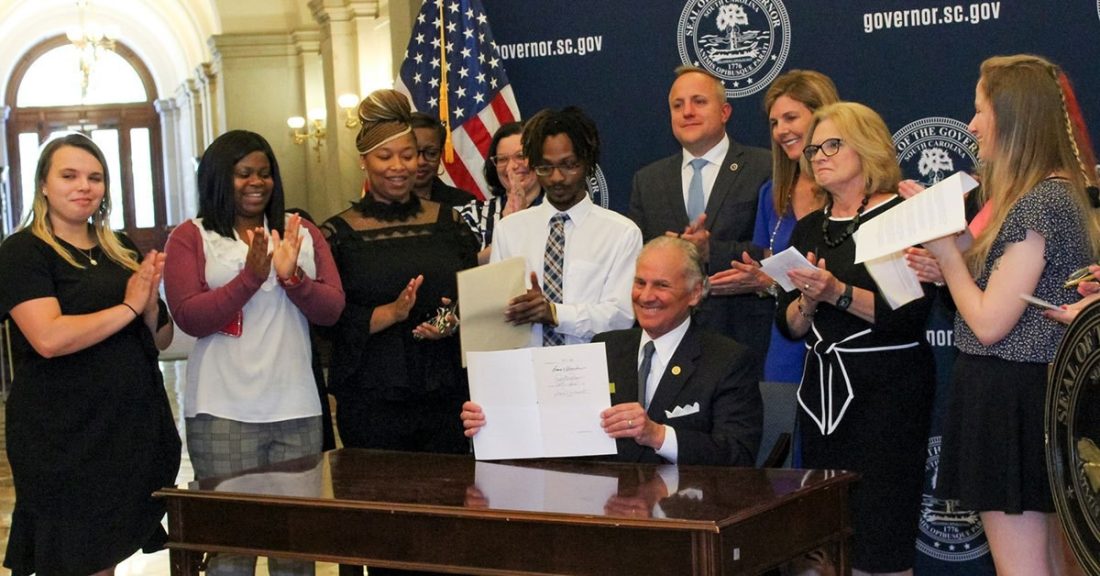South Carolina Moves to Strengthen Extended Foster Care

Young leaders joined South Carolina Gov. Henry McMaster as he signs new extended foster care law (Photo provided by the state's Department of Social Services)
There’s a new law in South Carolina — one that aims to help young people make a smoother, more successful leap from foster care to adulthood. The legislation paves the way for the state to tap into a significant funding source — the federal government — to help cover the costs of its extended foster care programming, which serves young adults between the ages of 18 and 21.
Prior to passing this law, South Carolina footed the full bill for its extended foster care services. As of May 1, 2022, 164 young adults across the state were utilizing this support.
Now, with federal dollars added to the mix, officials anticipate hiring more caseworkers and tailoring support to meet the needs of more youth, says Connelly-Anne Ragley, who directs communications and external affairs for the state’s Department of Social Services, which has received technical assistance from the Annie E. Casey Foundation.
Youth Advocate for Improving Extended Care — and Succeed
“We, as foster youth, deserve a safe space, no matter our age,” says Sierra Burns, 20, who is in extended foster care in South Carolina. Burns has been active with the state’s youth advisory council and advocated for the new legislation alongside other council members.
When the bill was signed into law on May 11, 2022, Burns attended the ceremony and shared her story about aging out of care.
“I felt I was ready,” Burns recalls of her leap to independence and out of the foster care system. But, she quickly learned otherwise. “I needed emergency housing two months after I turned 18. Without reaching out, I would have been homeless and would have been unable to provide food or any other basic needs for myself.”
Today, Burns says that she feels better prepared for adulthood as she nears age 21, and she wants her peers to enjoy this same sense of security.
“Trauma does not disappear once we turn 18,” she told the crowd on hand for the bill-signing ceremony. “I want you all to know, from a youth perspective, this is a huge step of progress that will make future youths’ lives change —for the better.”
The National Picture for Extended Foster Care
Nearly 15 years after federal support became available for extended foster care, 49 states and the District of Columbia have adopted such programming. Two exceptions — Oklahoma and Puerto Rico — still lack similar programming for youth who turn 18 while in care.
Despite these gains, more than half of the older teens exiting foster care each year — an estimated 20,000 young people nationally — are thrust into independence upon reaching their state’s age of majority. The risk of emancipation varies: Compared to their white peers, Black teens are 24% more likely and Latino teens 17% more likely to age out of care, according to national data from 2020.
Like Burns, many emancipated youth struggle without the safety net and support of permanent family, guardians or kin caregivers. Their introduction to adulthood is mired with increased rates of homelessness, hunger, academic interruptions, criminal activity, missed medical care, unwanted pregnancy and other harms, research shows.
Even when state programming is available, young people don’t automatically benefit from it. For example: Just 25% of eligible 19-year-olds were utilizing their state’s extended care programs before the pandemic, according to a Casey Foundation analysis. A significant but short-lived change occurred during the pandemic, with Congress passing a temporary moratorium on youth aging out of care. This stay expired in fall 2021.
Two Steps for Lawmakers to Consider
Policymakers looking to do more can follow South Carolina’s example and combine existing state and federal resources to better serve young people in extended care, says Leslie Gross, director of the Casey Foundation’s Family Well-Being Strategy Group.
“Child welfare systems are responsible for building a stronger bridge to adulthood for all youth in their care,” Gross explains. “A combination of greater federal and state partnership and investment is necessary to ensure that every young person who reaches age 18 while in foster care has the comprehensive and ongoing support they need to thrive as adults.”
Beyond leveraging federal resources, says Gross, states can also follow South Carolina’s example in another way — by engaging “youth in the design and delivery of effective programming.”





